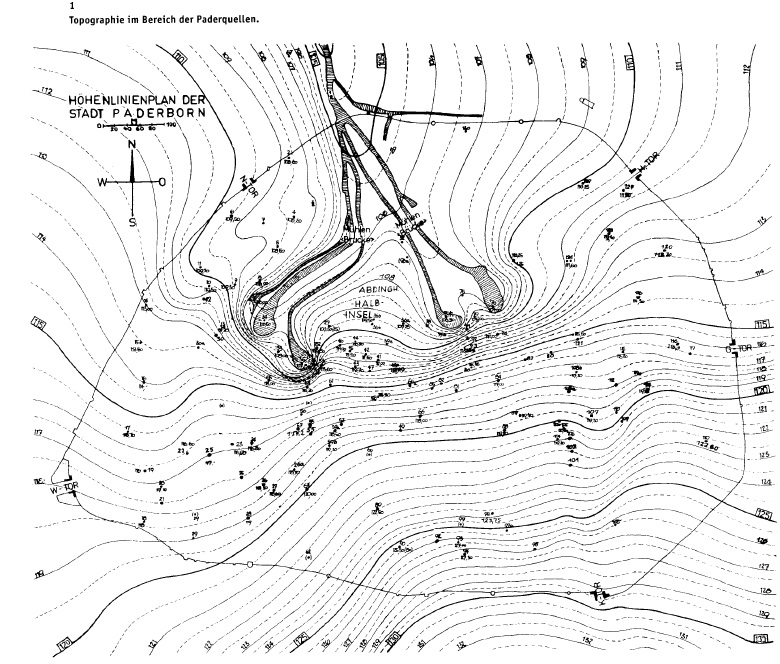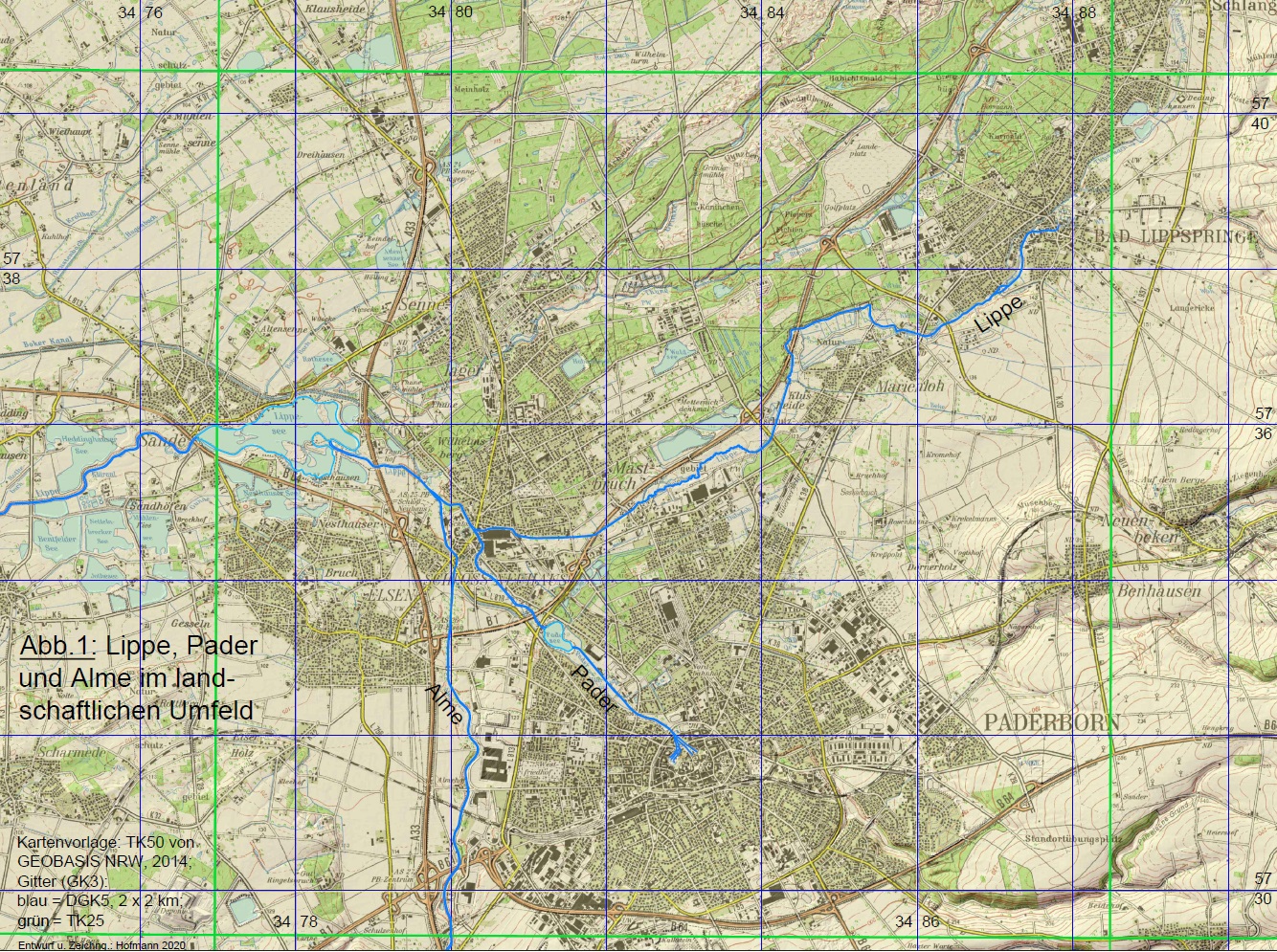[1] „In eastern Westphalia, …. one does not speak of a ‚valley‘, but of a ‚Grund‘ – the word is feminine in the dialect and in older land registers, … the Krumme Grund“; JOSEF ROHRBACH, Die Paderborner Feldmark. Flurnamen und Flurgeschichte (Schriftenreihe des Paderborner Heimatvereins, H. 1), 2. Aufl. Paderborn 1963, p. 34.
[2] The geological map 1:25,000, sheet 4218 Paderborn, and a „hydrogeological section through the subsoil of the urban area of Paderborn“ presented by Gert Michel in the explanations to this map (p. 94, Fig. 16) document the natural specifications; Geologische Karte von Nordrhein-Westfalen 1:25.000, Blatt 4218 Paderborn, edited by Klaus Skupin, published by Geologisches Landesamt Nordrhein-Westfalen, Krefeld 1982; GERT MICHEL, Hydrogeologie, in: Erläuterungen zu Blatt 4218 Paderborn, edited by Klaus Skupin, Krefeld 1982; (Geologische Karte von Nordrhein-Westfalen 1:25.000), Krefeld 1982, p. 92-107, Fig. 15-18, Tab. 10-15; KLAUS SKUPIN, Erläuterungen zu Blatt 4218 Paderborn, edited by Klaus Skulpin, Krefeld 1982.
[3] Photographically, this slope is well highlighted in LUDWIG MAASJOST/GERHARD MÜLLER, Paderborn. Das Bild der Stadt und ihrer Umgebung, Paderborn 1977, S. 22, Fig. 18, p. 34ff.
[4] MICHEL (as in note 2).
[5] BERNHARD ORTMANN, Die Ältesten Befestigungen innerhalb der Altstadt von Paderborn seit karolingischer Zeit. Zum Paderborner Jubiläum 777-1977, Felsberg 1977, p. 5-10.
[6] MANFRED BALZER, Paderborn im frühen Mittelalter (776-1050). Sächsische Siedlung – karolingischer Pfalzort – ottonisch- salische Bischofsstadt, in: Das Mittelalter. Bischofsherrschaft und Stadtgemeinde, hg. v. Jörg Jarnut (Paderborn. Geschichte der Stadt in ihrer Region, Bd. 1), Paderborn 1999, S. 2-118, hier S. 6, Abb. 1; GEORG EGGENSTEIN, Die Ausgrabungen des mittelalterlichen Hellweges in Balhorn bei Paderborn, in: Archäologie im Paderborner und Corveyer Land. Schlaglichter auf 6000 Jahre Geschichte, hg. v. Georg Eggenstein (Heimatkundliche Schriftenreihe/Volksbank Paderborn, H. 34), Paderborn 2003, S. 22-31, hier S. 22ff.
[7] SVEVA GAI, Von der Pfalzanlage Karls des Großen zur Bischofsstadt. Die Topographie der Domburg zwischen dem 8. und dem 13. Jahrhundert, in: Stadt Paderborn, published by Landschaftsverband Westfalen-Lippe and Stadt Paderborn, edited by Heinrich Otten (Denkmäler in Westfalen, Bd. 2.1), Petersberg 2018, p. 39-50; WILHELM GRABE, Die Geschichte der Stadt Paderborn, in: Stadt Paderborn, published by Landschaftsverband Westfalen-Lippe and Stadt Paderborn, edited by Heinrich Otten (Denkmäler in Westfalen, Bd. 2.1), Petersberg 2018, p. 51-73; SVEN SPIONG, Paderborn aus archäologischer Sicht. Von den ersten Siedlern bis zur geplanten Stadt im 12. Jahrhundert, in: Stadt Paderborn. published by Landschaftsverband Westfalen-Lippe and Stadt Paderborn, edited by Heinrich Otten(Denkmäler in Westfalen,Vol. 2.1), Petersberg 2018, p. 15-38.
[8] BALZER (as in note 6), pp. 13.; GAI (as in note 7).
[9] Cf. in summary SPIONG (as in note 7), p. 15-38.
[10] SVEVA GAI/BIRGIT MECKE, Est locus insignis… Die Pfalz Karls des Großen in Paderborn und ihre bauliche Entwicklung bis zum Jahre 1002. Die Neuauswertung der Ausgrabungen von Wilhelm Winkelmann in den Jahren 1964-1978, Vol. 1 (Denkmalpflege und Forschung in Westfalen, Vol. 40,1-2), Mainz 2004; SVEN SPIONG, Von der bischöflichen Residenz zur mittelalterlichen Stadt. Die Stadtgenese Paderborns im Spiegel neuer archäologischer Ausgrabungen, in: Bischöfliches Bauen im 11. Jahrhundert. Archäologisch-historisches Forum, edited by Jörg Jarnut/Ansgar Köb/Matthias Wemhoff, (Mittelalter Studien des Instituts zur Interdisziplinären Erforschung des Mittelalters und seines Nachwirkens, Vol. 18), München 2009, p. 173-190; ULRICH KAPLAN, Der mittelalterliche Steinbruch des Bischofs Meinwerk und das Unterconiacium (Oberkreide) bei Paderborn (südöstliches Münsterländer Kreidebecken), in: Geologie und Paläontologie in Westfalen 83, 2012, p. 5-51.
[11] KAPLAN (as in note 10), p. 5-7.
[12] Until the 19th century, household waste and faeces, as far as they were not taken to the nearby fields or gardens for fertilisation, were usually disposed of via the flowing waters.
[13] MAASJOST/MÜLLER (as in note 3), pp. 128., Fig. 186f.
[14] BALZER (as in note 6), p. 7, 117.
[15] For explanations on alluvial fans cf. MANFRED HOFMANN, Krumme Grund. Ein folgenreicher Eingriff in einen Wasserlauf im Südosten von Paderborn, in: Die Warte, Nr. 177, 77, 2018, p. 29-30.
[16] ALFRED COHAUSZ, Erconrads Translatio S. Liborii. Eine wiederentdeckte Geschichtsquelle der Karolingerzeit und die schon bekannten Übertragungsberichte mit einer Einführung, Erläuterungen und deutscher Übersetzung des Erconrad (Studien und Quellen zur Westfälischen Geschichte, Vol. 6), Paderborn 1966; BALZER (as in note 6), p. 4f.
[17] BERNHARD DACHNER, Beobachtungen zum Abflußverhalten der Pader und der Paderquellen, in: Südost-Westfalen. Potentiale und Planungsprobleme einer Wachstumsregion (Spieker. Landeskundliche Beiträge und Berichte; H. 35), Münster 1991, p. 65-82; MANFRED HOFMANN, Quellen in Paderborn. Entstehung, Bedeutung, Schutz, in: Le Mans und Paderborn. Zwanzig Jahre Partnerschaft zwischen der Université du Maine und der Universität Paderborn (Paderborner Geographische Studien, Vol. 5), Paderborn 1993, p. 25-41.
[18] At the level measuring point below the Padersee, where the water from all sources, including those draining via the Rothebach, and a large part of the rainwater runoff from the urban area have come together, a discharge of between 4-6 m³/s is usually determined, with a downward trend in recent times.
[19] MICHEL (as in note 2).




